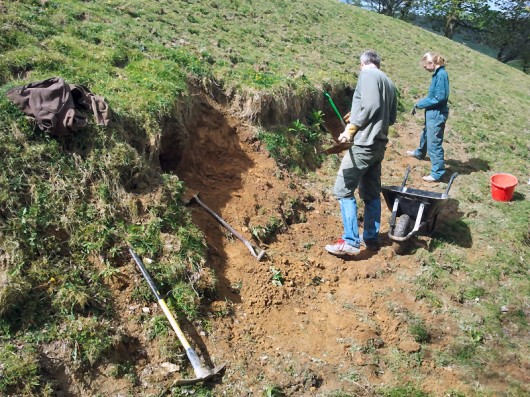Time Scale and Costings
Time Scale and Costings of the Clay Plaster
Our Time scale
(starting april)
Month 1 – Week 1 Soil testing. Possibly needing a week for samples to dry
Week 2 – Narrow down results and harvest enough for test plaster mixes. Test plaster mixes
Week 3 – Await plaster mix results (could harvest big batches of earth if the right area has been identified at soil testing stage)
Week 4 – Await plaster test results (could be drying out and sifting earth, gathering materials)
Month 2 (test bale/ wall probably not dry yet, so time scale shifts forwards if so)
Week 1 Decide on plaster mix/ go back to testing more. If decided get started! Organize & arrange volunteers, begin mixing plaster and slip and application. Times for this very dependant on number of people and size of area!
Week 2 1st coat mixing and applying continued
Week 3 – Wait for 1st coat plaster to dry
Week 4 – Wait for 1st coat to dry
Month 3 – If there are any areas dry/ using a test bale you could start testing for second coat, but this might be jumping the gun.
Week 1 – waiting for plaster to dry
Week 2 – waiting for plaster to dry
Week 3 – waiting for plaster to dry ,possibly testing second coat if first is dry
Week 4 – awaiting second coat results (might need to gather more earth and process)
Month 4
Week 1 – awaiting second coat testing results
Week 2 -If results are in, get started mixing and applying second coat
Week 3 -Mixing and applying second coat
Week 4 – Wait for second coat to dry
Month 5
Week 1 – wait for second coat to dry
Week 2 – wait for second coat to dry (can be gathering equipment and resources for final coat)
Week 3 – final coat testing and waiting for results
Week 4 – test finishes and effects, begin third coat plastering
Month 6
Week 1 – final coat plastering cont.
Week 2 – Wait for final coat to dry
Week 3 – Apply finishes
Remember this is just what we did. Some people are happy to put another coat of plaster on before the one below is completely dry. This would sped things up a LOT. But we didn’t think it prudent here in the UK, and because each coat was semi-experimental, we wanted to make sure it was sound before continuing. If you were using commercially bought clay, you might well be confident enough to continue onto the next coat before complete dryness… If you have any mould growth, this would not be recommended.
Rough costings:
This will totally depend on what tools etc you have already, what finishes used etc. But this is what we think it cost in money terms
Tarpauilin with no holes for the pit: 14.99
Sand (1 ton bag) £30
Plastic polishing float £6
Earthborn glaze about £20 a tin x 2 = £40
Limewash £18 20 litre tub x 2 = £36
Large plastering trowel = £18
Food and drink for volunteers about £100
Extra dust pan brush = £1
Total estimate: £245.99
